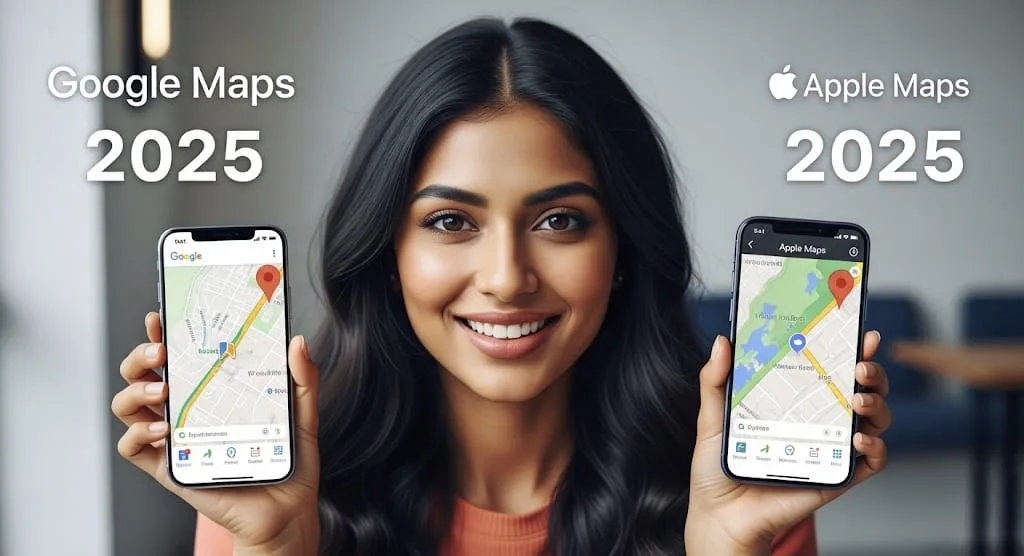In the ever-evolving landscape of digital navigation, Google Maps and Apple Maps continue their long-standing rivalry. As we navigate through 2025, both platforms have introduced significant enhancements, pushing the boundaries of what a mapping application can do. For users worldwide, the critical question remains: which one offers the superior experience? This article dives deep into their current capabilities, highlighting their strengths and weaknesses to help you decide.
The Evolution of Navigation: A Look Back and Forward
Gone are the days when a mapping app was just about getting from point A to point B. In 2025, navigation apps are sophisticated tools, offering real-time insights, personalized recommendations, and seamless integration with our daily lives. Both Google and Apple have invested heavily in AI, augmented reality (AR), and data collection to deliver a more immersive and efficient experience. While Google Maps, with its decade-long head start, has traditionally been the market leader, Apple Maps has rapidly closed the gap, especially within the Apple ecosystem.
Core Functionality: Accuracy and Real-time Data
At the heart of any navigation app is its ability to provide accurate directions and real-time traffic updates. In 2025, both Google Maps and Apple Maps excel in this regard, offering highly reliable routing for driving, walking, cycling, and public transport.
- Google Maps leverages its vast network of users and extensive historical data to provide incredibly precise traffic predictions and alternative routes, often factoring in details like fuel efficiency. Its global coverage remains unparalleled, making it a go-to for international travel.
- Apple Maps, though once criticized for inaccuracies, has undergone a massive overhaul. Its new map data, built from high-resolution satellite imagery and LiDAR scans, has significantly improved its accuracy, particularly in major cities. Users often praise Apple Maps’ clearer voice guidance, which provides more natural instructions (e.g., “turn at the next traffic light” instead of precise meters).
However, Google Maps still maintains a slight edge in its sheer volume of Points of Interest (POI) and business information, with more frequent updates and community-driven insights.
User Interface and Experience: Clean vs. Comprehensive
The look and feel of a navigation app can heavily influence user preference. In 2025, both platforms offer distinct approaches to their user interfaces.
- Apple Maps prioritizes a clean, minimalistic design. Its interface is less cluttered, with fewer buttons and a focus on visual clarity. This design choice makes it particularly intuitive for users deeply embedded in the Apple ecosystem, offering seamless integration with Siri and CarPlay. Its 3D city maps and Look Around feature provide a visually rich experience.
- Google Maps, while still user-friendly, presents a more comprehensive and feature-rich interface. Its strength lies in the sheer amount of information it presents, from Street View imagery to detailed business reviews and photos. This can sometimes lead to a slightly busier appearance, but it offers unparalleled depth for those seeking detailed local information.
Advanced Features: Beyond Basic Navigation
Beyond the core navigation, both Google and Apple Maps have introduced a plethora of advanced features in 2025 that enhance the overall user experience.
- Google Maps continues to innovate with features like Live View AR, which overlays directions onto your real-world surroundings, and advanced EV routing that considers battery range and charging stops. Its multi-stop planning feature remains a favorite for road trippers. Google’s strong local SEO capabilities also make it a vital tool for businesses.
- Apple Maps is focusing on deeper integration with the iOS ecosystem. With the release of iOS 26, Apple Maps has introduced new features for CarPlay, and its integration with Apple Intelligence promises more context-aware suggestions. Apple Maps has also significantly improved its integration of expert reviews from sources like the MICHELIN Guide for restaurants and hotels. Its privacy-focused approach, which “fuzzes” user locations and avoids storing search history, is a significant draw for many.
Data Privacy: A Growing Concern
In an age where data privacy is paramount, the approaches of Google Maps and Apple Maps diverge significantly.
- Google Maps collects vast amounts of user data to improve its services and offer personalized recommendations. While Google offers an Incognito mode to limit data saving, user data still passes through its servers.
- Apple Maps has built its platform with privacy at its core. It employs techniques like “fuzzing” to generalize user locations and avoids storing search or trip data, making it a preferred choice for privacy-conscious individuals.
Offline Capabilities: Navigating Without Connectivity
For travelers in areas with limited connectivity, offline maps are crucial.
- Google Maps offers robust offline map downloads, allowing users to save entire regions or cities for navigation without an internet connection.
- Apple Maps has made strides in its offline capabilities, though it still primarily relies on cached data rather than full, downloadable offline maps like Google.
Feature Highlights: A Quick Comparison
| Feature Category | Google Maps | Apple Maps |
| Accuracy & Coverage | Extensive global coverage, real-time traffic, vast POI data. | Improved accuracy, especially in cities, natural voice guidance. |
| User Interface | Feature-rich, comprehensive, more data display. | Clean, minimalistic, intuitive, deep Apple ecosystem integration. |
| Advanced Features | Live View AR, advanced EV routing, multi-stop planning. | Seamless CarPlay integration, expert reviews (e.g., Michelin), privacy-focused. |
| Privacy | Data collection for personalization, Incognito mode available. | Privacy-first design, “fuzzing” of locations, no search history storage. |
The Verdict for 2025 🏆
In 2025, the choice between Google Maps and Apple Maps largely comes down to personal priorities and ecosystem preference.
If you value unparalleled data richness, global reach, advanced AI-driven features, and comprehensive business information, Google Maps remains the dominant force. It’s the powerhouse for exploration and detailed planning, especially for Android users and those who venture beyond major urban centers.
However, if you are an Apple user who prioritizes a cleaner interface, privacy, and seamless integration with your Apple devices (especially in your car via CarPlay), Apple Maps has evolved into a highly competent and often preferred alternative. Its improvements in accuracy and intuitive design make it a strong contender for daily navigation.
Ultimately, both platforms offer exceptional navigation experiences in 2025. The “better” app is the one that best suits your individual needs and integrates most effectively into your digital life. Why not try both and see which one guides you best? 😉
Frequently Asked Questions (FAQs)
1. Is Apple Maps truly as accurate as Google Maps in 2025?
Apple Maps has significantly improved its accuracy in 2025, especially in urban areas with its new map data. While Google Maps still holds an edge in sheer global data breadth and real-time updates for obscure locations, Apple Maps is now a highly reliable option for most daily navigation needs.
2. Which app is better for public transportation?
Google Maps generally offers more comprehensive and detailed public transportation information globally, including real-time schedules, platform numbers, and crowding estimates. Apple Maps provides transit information, but its coverage might be less extensive in some regions.
3. Can I use offline maps effectively on both platforms?
Yes, both platforms offer offline map capabilities. Google Maps allows for more extensive pre-downloading of large regions for truly offline navigation. Apple Maps largely relies on caching data and offers more limited offline functionality compared to Google.



